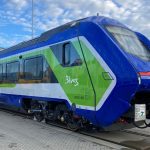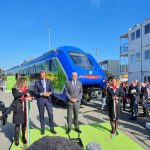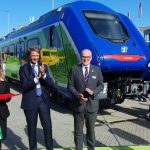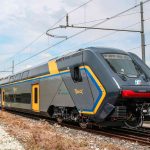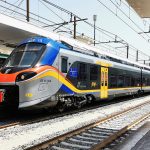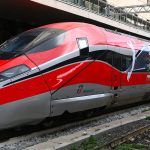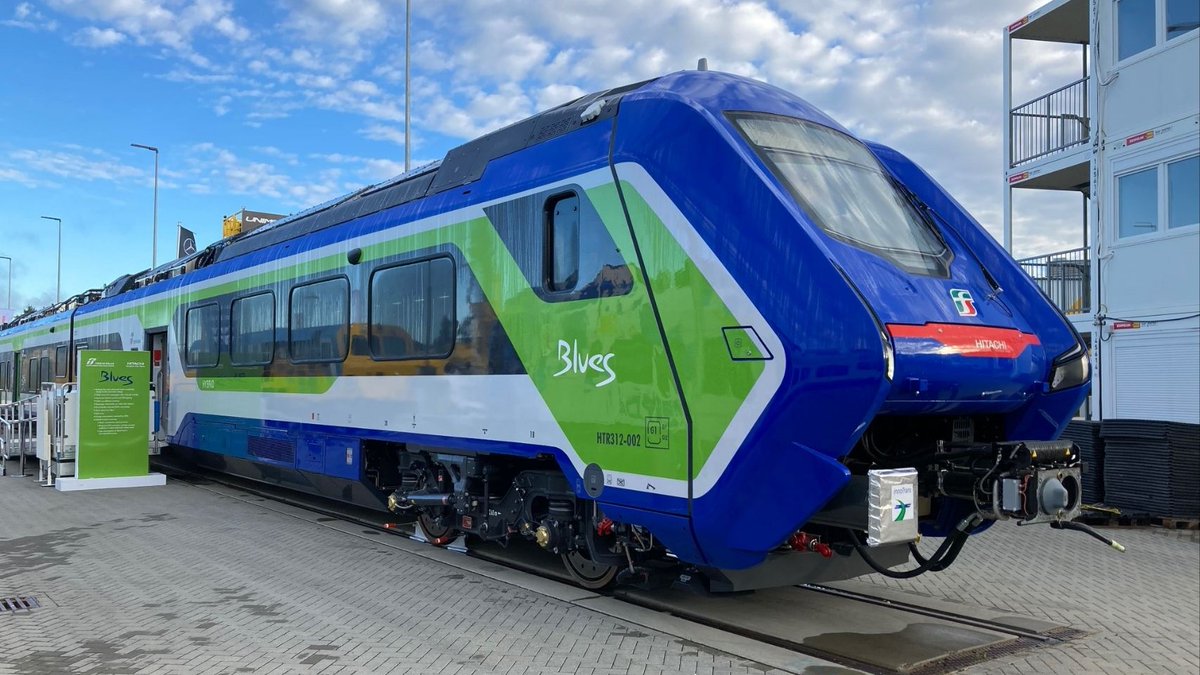 Hitachi Rail and Trenitalia have unveiled the Blues battery hybrid train which will enter passenger service by the end of this year. Trenitalia and Hitachi Rail signed a EUR 1.2 billion framework agreement for the supply of up to 135 trains.
Hitachi Rail and Trenitalia have unveiled the Blues battery hybrid train which will enter passenger service by the end of this year. Trenitalia and Hitachi Rail signed a EUR 1.2 billion framework agreement for the supply of up to 135 trains.
The Blues train will make its debut in Sicily and Sardinia by the end of this year and will also provide services in Tuscany, Lazio, Calabria and Friuli Venezia-Giulia starting 2023.
The train will be the first ever tri-mode – using battery, electric and diesel power – fleet to enter passenger service in Europe, later this year.
The new train based on the Masaccio platform will reduce carbon emissions and fuel consumption by 50% and has the ability to arrive at and depart from stations completely under battery power.
The new four-car trains have been manufactured at Hitachi Rail’s factories in Pistoia and Naples, and can accommodate up to 300 people seated.
The tri-mode Blues train represents a significant breakthrough in the market, with its ability to operate seamlessly on electrified and non-electrified lines. On electrified routes, it uses pantographs to draw power from the overhead lines and when it moves to non-electrified lines, usually smaller regional routes, a combination of battery and diesel power takes over.
When it is near a station, the batteries power the train completely, eliminating emissions including harmful NOx and reducing noise pollution. The battery is able to recharge while the train is in operation, both in diesel and electric mode.
“The Blues train, with its pioneering battery hybrid technology, is a hugely important way for railways across Europe to reduce their carbon emissions, while improving passengers’ journeys,” Andrew Barr, Group CEO, Hitachi Rail, said.
The train will offer more seamless, sustainable travel for passengers running at a maximum speed of 160 km/h. The extra power offered by the on-board batteries means the Blues train’s acceleration and performance is superior to existing diesel trains, allowing it to offer reduced journey times for passengers.
The fleet has been designed to accommodate families and leisure travellers, as well as regular commuters, with features including greater capacity for luggage and bikes, air conditioning, more USB and power sockets for greater connectivity, and an area entirely dedicated to children. The fleet has been designed with platform level door access to increase the ease of entry and departure for wheelchair users or passengers with buggies or large bags. It also boasts the latest in passenger information screens (24 inches), passenger counting technology and excellent access for people with limited mobility.
The Blues battery hybrid train is equipped with innovative ERTMS digital signalling, which has up until now only been used on high speed trains. This system supports the reduction of the railway’s energy and emissions footprint by regulating the speed, acceleration and braking of trains. ERTMS also boosts safety by enabling the automatic activation of train safety functions, including emergency braking in case of danger or if trains exceed the track’s line speed.
110 Blues trains will arrive in Italy, and they are part of the broader renewal plan of the Trenitalia fleet for regional transport. Trenitalia is investing EUR 8 billion for new rolling stock making among the youngest and greenest in Europe. “The arrival of the Blues trains will contribute, together with the deliveries of the new Rock and Pop trains, to make our regional fleet among the youngest in Europe with an average age of seven years,” Luigi Ferraris, CEO of the FS Italiane Group said.
The Passenger Hub, part of the 2022-31 industrial plan, provides EUR 15 billion to promote collective and integrated transport, with EUR 8 billion delivered for train renewal programme.
At InnoTrans, FS Italiane presented the new trains from Siemens Mobility and Stadler for Netinera, the German subsidiary of the group.
The company has also presented version 3.0 of the Nikrasa system used by TX Logistik, an innovative solution to load quickly and without investment on the terminals semi-trailers on railway wagons. Considering that 90% of the trailers cannot be lifted, Nikrasa will contribute to the modal shift in favor of rail transport over long distances and a smaller footprint in the terminals. A system that, in version 3.0, boasts a much lighter transport base for the semi-trailer that allows even more goods to be transported by rail. The new system is part of the Logistics Hub with EUR 2.5 billion investment to double the share of goods transported by rail, in line with the ten-year Industrial Plan.
“The key word is integration. Integration between ports, roads, railways and airports. We as a group must progressively become from rail freight transporters to system operators, adopting a structured approach that allows us to intercept the flows of goods in a playing field that is the European one,” the CEO of the FS Italiane said.
As part of its rail strategy, FS Italiane is also investing in rail network modernisation and expansion plan. FS estimates that EUR 110 billion will be needed for the rail infrastructure which also includes the introduction of new technologies. This summer, the CEO of FS announced that EUR 19 billion tenders will be launched for rail infrastructure projects.
Company’s 2031 plan unveiled this year covers a EUR 190 billion investment to develop Italy’s railway transport.
Share on:



